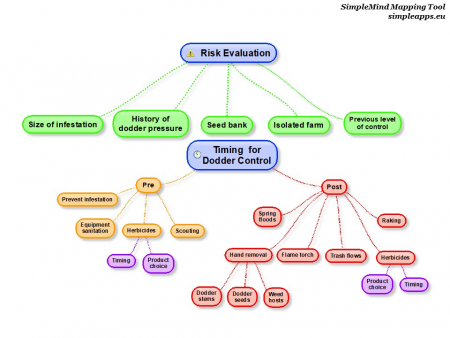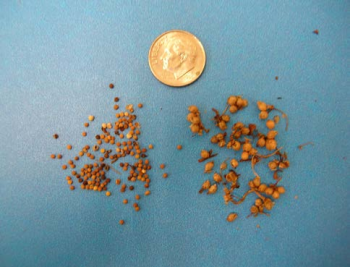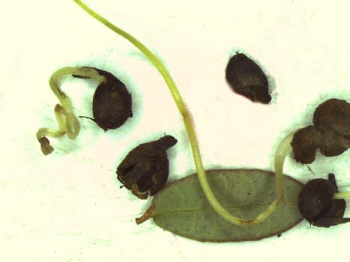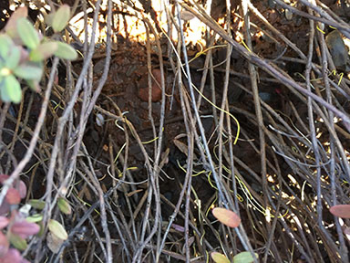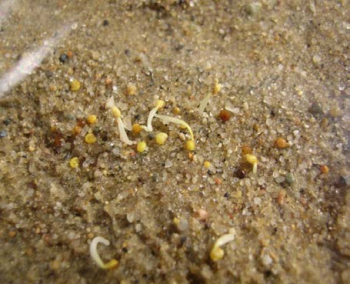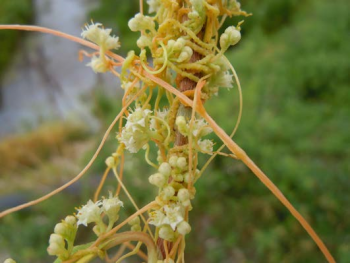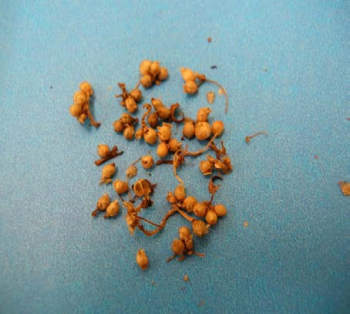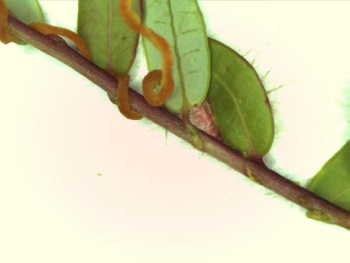Dodder: Biology and Management
Dodder:
Biology and Management
Dodders (Cuscuta spp.) are obligate parasitic plants consisting of yellow twining stems that produce small clusters of white flowers. The stems will wrap around the host and insert specialized structures (haustoria) into the host plant. The haustoria establish a physical connection between the dodder and the host that permits the withdrawal of nutrients and water from the host to the dodder plant.
Dodder is a serious threat to the sustainable production of cranberries in Southeastern Massachusetts and can be
problematic in other cranberry production areas including New Jersey and Wisconsin. In commercial production areas, dodder spreads rapidly, damages cranberry vines significantly and can reduce yields 80% to 100% in infested areas. Many management options available to growers of annuals crops (e.g., altering time of planting, crop rotation, resistant varieties, etc.) are not possible in cranberry. The key to
sustainable management of this serious pest will require a combination of chemical and cultural approaches, supported by understanding the complicated nature of dodder biology.
Taxonomy/Classification/Diversity
Dodder is in the genus, Cuscuta, which has about 150 species of yellow, orange, or red (rarely green) parasitic plants. Some taxonomists clumped dodders into their own family, Cuscutaceae, but most now accept it as belonging in the morning glory family, Convolvulaceae. It is also known by many common names including golden thread, hairweed, and strangleweed.
In Massachusetts, the dodder that parasitizes cranberry has been assumed to be the single species, C. gronovii. However, a sample collected from a cranberry farm in Marion, MA in 2006 was identified to be C. cephalanthi Engelm.1. Additional collections of dodder in commercial farms and native sites in MA have indicated other species of Cuscuta are present. During the 2011 season, dodder samples were collected from 41 sites consisting of 39 commercial bogs and 2 naturally occurring populations. Identification indicated C. campestris and C. gronovii were both commonly found, and sometimes co-occurring, in Southeastern MA cranberry bogs; C. pentagona was detected at one commercial site (S. Stefanovic and M. Wright, unpublished data).
In summer of 2018, 426 dodder samples from 32 commercial bogs and six non-agricultural environments in MA were collected; samples were also collected from WI and NJ. Variation in stem diameter and stem color was observed across collected samples (A. Caicedo et al., unpublished data). We have been successful in developing an in-house genotyping-by-sequencing (GBS) protocol to carry out genome-wide characterization of single nucleotide polymorphism (SNPs) (J. Scott et al., unpublished data). Using this technique, we will be able to describe the genetic diversity present in dodder infestations, and how this diversity is structured across different sites. This research will increase our understanding about the relationships between weedy dodders in cranberry bogs and wild dodders that occur in noncommercial sites.
Life cycle and Biology
Although typically considered an annual plant (completing its full life cycle in one year), overwintering of haustoria can occur in some species, enabling the parasite to produce shoots in the spring without relying on seed germination. Thousands of seeds are produced by dodder in a given year; its seeds are very long-lived and those produced in a single year can persist in the soil and germinate over 20+ years. This strategy increases the probability that a seed (and seedling) will encounter suitable environmental conditions for growth and reproduction.
Dodder seed is physically dormant. A hard seed coat prevents the seed from imbibing water that is necessary for the seed to germinate. Seeds must be scarified (i.e., scratching, etching, or rubbing the surface of the seed) before germination can occur. After germination, a seedling can search (circumnutate) for several days for a suitable host. In cranberry, dodder parasitizes the vine to the extent needed to ensure its own survival; it weakens, but rarely kills its host (uprights or weeds). An infected cranberry plant can survive but is usually stressed to the point where fruit production is greatly reduced.
Dodder is well adapted to the cranberry system (see following figure). Starting in late April-May, dodder seeds germinate and seedlings search for hosts just as the tender new growth is extending on the upright. Susceptible weed hosts that germinate early in the season (e.g., narrow-leaf goldenrod) can be parasitized by dodder during this time frame. The dodder stem will encircle the cranberry (or other host) stem several times and then slow the stem elongation process. It then forms a natural graft by producing haustoria, specialized structures that penetrate the host plant and make a physical (cellular) connection between the parasite and the vascular system (xylem and phloem) of the host. Although dodder can successfully penetrate and parasitize woody tissues, young, tender tissues (e.g., new cranberry growth, emerging weeds), which are present when dodder seedlings are searching in the early spring, offer a prime substrate for establishing these connections.
Once the haustorial connections are made, the dodder stems re-start the elongation process and search for other stems to parasitize. This growth eventually becomes the network of stems that typify a dodder infestation. Cranberry flowers in June; dodder typically flowers in July. Dodder seeds are produced in capsules in late August-September; the dodder stem senesces (dries out and dies back) during the seed-set stage. Typically 3-4 seeds are formed in each capsule. An infected host could have 100s of capsules on a single stem.
The seed capsules can be easily dispersed during typical horticultural practices, such as harvesting. Seed capsules are dislodged from their hosts as the harvesting equipment separates the berries from the vines. During water harvest, the capsules can float in water and disperse widely; they are very difficult to completely separate from the cranberry fruit. However, some growers have fabricated filter and vacuum systems that can separate dodder seeds during trash floods. After harvest, seed capsules fall to the bog surface and will overwinter there. During the winter months, the capsules break apart and the seeds become scarified, breaking seed dormancy, allowing for the seeds to imbibe water and germinate in the spring, which starts the cycle over again.
 Nonchemical Management
Nonchemical Management
Preventing seeds from entering the bog system is the best nonchemical approach. Equipment should be cleaned when moving between infested and clean farms. Efforts should be made to minimize movement of seed capsules in harvest or other flood waters. If possible, remove infected weed hosts prior to harvest to minimize seeds deposited on the bog floor. Application of thin layers of sand to the cranberry vines and short-term floods can control a portion of early emerging dodder population in cranberry production and are discussed below. Control of early season weed hosts have been observed to reduce dodder infestations in cranberry (M. Else, unpublished data) and is a recommended practice.
Mechanical or nonchemical removal of infestations can be used for dodder control. The removal of stems has many benefits, including increased sunlight penetration into the canopy, reduced nutrient loss in the cranberry vine, and the potential to reduce the number of dodder seeds produced. Any practice that leads to decreased seed production should aid in the reduction of future dodder infestations and is highly recommended. Mowing around ditches and reservoirs to reduce the number of weed hosts for dodder is a recommended practice. Removal of dodder early in the season by hand (very labor-intensive) or during the postharvest (de-trashing) flood helps to minimize the spread of dodder. Hand-held bamboo rakes are also used to break the mat of dodder stems that have twined around uprights during mid-summer when dodder is flowering. Raking dodder infestations is beneficial if the infestations are severe; no additional benefits were obtained by raking more than once. Raking is normally conducted when cranberry fruit are present and can easily detach fruit from the upright. Multiple rakings may dislodge even more fruit, making treated areas as low-yielding as the infested areas.
Flooding. Holding 18- to 30-hour floods during May gave a 65 to 89% reduction in pesticide use for dodder management when short-term spring floods were implemented during 2001-2003 compared to the previous 3-year period (grower data). A 2-year demonstration project documented intermittent efficacy of short-term floods. Subsequent studies indicated flooding 4 weeks after the first seedling emergence (FSE) resulted in the lowest dodder attachment compared to floods initiated 1, 2, or 3 weeks after FSE. Post-harvest floods can remove a portion of dodder seed capsules from the bog and is a recommended practice. If all capsules are not removed (a likely event), floods can spread seeds when water is pumped during harvest operations. Cranberries are at risk for carbohydrate reduction with fall floods so care must be taken when utilizing this cultural practice. Consultation with an Extension Specialist is recommended when considering flooding options.
Sanding. The application of at least 0.5 inch of sand on top of dodder seeds was needed to reduce seedling emergence in greenhouse tests (though not always different from the untreated control); seedling emergence decreased >66% compared to the untreated control with 1 inch of sand. Keep in mind that sanding can be very nonuniform; extensive field measurements indicated that sand deposition was very irregular. As a consequence, reports of dodder control with sanding has been variable. To achieve consistent pest control from sanding, improved technology is needed to deposit uniform layers of sand to the bog surface. Also, clean sand should be used so that weed seeds are not introduced during the sanding process.
Flame cultivation (FC), through the use of hand-held propane torches, can reduce dodder infestations, and most importantly, dodder seed production when the treatment is applied before or during flowering, prior to seed formation. Dodder was exposed to various durations of infrared (IR) or open flame (OF) torches; seed production was significantly lower when treated during flowering. Negative impacts on cranberry growth are usually minimal and short-lived and well worth the benefits gained by eliminating dodder seeds.
Resistant varieties are not currently available in cranberry production. Recent research (Tjiurutue et al. 2016, J. Chemical Ecology) supported anecdotal observations that Early Black vines were less preferred (had fewer dodder attachments) than several other common varieties grown in MA.
Biological Control. Several species of fungi have been shown to causes disease in dodder, but no biological control products are currently available for dodder control. A commercial product (Smolder) was developed using Alternaria destruens, however results from replicated trials conducted in 2007 in both Wisconsin and Massachusetts indicated that Smolder did not perform reliably in the field and further development of a commercial product was abandoned. Fusarium tricinctum and Colletotrichum gloeosporioides have also been identified as pathogens of dodder. Colletotrichum gloeosporioides has been isolated from diseased dodder plants in MA, but no attempts have been made to commercialize this fungus.
Current strategies for integrated management of dodder in cranberry
- Prevent movement of seeds onto the farm.
- Scout for newly emerged seedlings.
- Use pre-emergence herbicides.
- Manage early season weed hosts.
- Use short-term spring floods.
- Remove seedlings and infected hosts by hand in spring/early summer.
- Apply postemergence herbicides.
- Use hand-held flame torches.
- Keep ditches mowed to reduce number of susceptible hosts.
- Rake heavy dodder infestations once.
- Remove seed capsules/infected weed hosts prior to harvest.
- Remove dislodged seed pods in harvest and/or trash floods.
- Clean equipment between use on infested and clean farms.
- Apply uniform applications of sand.
- Use multi-criteria decision-making systems, such as AHP, to align your preferences and experiences with the development of an effective IPM program.
Possible future additions:
- Use of plant growth regulators
- New herbicides
- Resistant varieties
- Biological control products
Decision-Making Tools
Analytical Hierarchy Processing (AHP) is a mathematical model of multi-criteria decision making that uses pairwise comparisons, in conjunction with a ratio scale, to indicate the strength of preference or importance of various criteria. AHP enables users to set priorities and make decisions when both quantitative and qualitative elements need to be considered. Dodder was used as a case study for AHP as its management is not straight-forward; no single tactic provides adequate control across years and locations. An integrated approach must be used and often, a different approach may be needed for the same grower in one year as compared to the next. AHP can be used to help growers determine which criteria are important and which tactic(s) should be used in any given year.
We held multiple stakeholder focus groups with small groups (ca. 20-25 growers) to introduce and discuss AHP, identify the critical criteria, and develop a survey. We used SimpleMind mapping software to illustrate the relationships of the identified dodder management criteria in a visual flow-chart type diagram (see below). The maps were useful in developing the prototype ratio-scaled survey. The survey results can be entered into a spreadsheet, which calculates the values used to prioritize the selected criteria. Using a ratio scale format survey is very different from typical surveys. Growers were highly receptive to using AHP, but one-on-one help during the survey would help improve the reliability of the criteria prioritization.
Economics of Dodder Infestations and Their Management.
During the preparation of a Section 18 Emergency Exemption request (for the use of pronamide) in 2018-19, an economic table was constructed and is reproduced here, with minor modification. The following table gives examples, based on grower testimony and Extension experience, of the additional activities and costs associated with managing a dodder infestation on a MA cranberry farm. In addition to direct yield loss per year caused by dodder infestations, growers also invest time and money to manage the infestation, often to varying degrees of success. It is noteworthy that every situation may not require every task listed in the table; in addition, we recognize that this list may be incomplete.
| Not Infested | Infested | Loss (actual) | Loss (%) | |
| Deliverable yield (bbl/acre) | 274 | 179 | 95 | 35% |
| Gross revenue @ $32/bbl. Grower income is solely based on delivery of processed berries to the handler. | $8,768 | $5,728 | $3,040 | 35% |
| Actvities and costs of managing dodder, per acre | No Dodder | Dodder Infestations | ||
| Manage early emerging weed hosts with PRE herbicides (ex. 50 lb/A norflurazon or 18 qt/A napropamide)* plus labor ($20-$34/A depending on application method; mid rate used) | $0 | $227 | ||
| Scouting to determine emergence of dodder seedlings (0.5 hr/A vs 2 hr/A @$15/hr)* | $8 | $30 | ||
| Manage early emerging dodder with dichlobenil @ 60 lb/A, plus ground application labor ($34/A) | $0 | $184 | ||
| Hand removal of dodder seedlings (2 hr/A @ $15/hr)* | $0 | $30 | ||
| POST herbicides to control infestations (e.g., spot treat concentrated sprays of mesotrione), labor + product* | $0 | $50 | ||
| Harvest labor (5 A/day vs 2.4 A/day, 8 hr/day at $15/hr) | $24 | $50 | ||
| Estimated 70% loss of pollinator efficacy (2 hives/A @ $90/hive) due to dodder stems in canopy* | $0 | $126 | ||
| Flood, remove, and re-flood to avoid dissemination of dodder seeds (includes fuel, labor) | $0 | $161 | ||
| Rake and remove dodder stems and seed pods | $0 | $90 | ||
| Fruit loss from raking and foot traffic (8 bbl/A) | $0 | $256 | ||
| Post-harvest flood to remove abscised cranberry leaves and dodder seeds | $38 | $80 | ||
| Total Costs | $70 | $1,284 | $1,215 | |
| Net Revenue | $8,699 | $4,444 | -$4,255 | 49% |
Estimates of yield loss and management costs provided by MA growers who have not been able to control dodder with currently available options.
*Estimates based on ag supplier prices and/or personal experience by growers and/or Sandler.
In the example given here (actual grower data), an uncontrolled dodder infestation caused a 35% yield loss of the total crop (direct loss of payment received due to reduced fruit delivered). In this scenario, the grower tried to control dodder (e.g., applied herbicides, hand-weeded, raked the dodder) and still lost 35% of the crop. It is possible that the loss might have been even higher if none of these actions were taken. However, since previous dodder infestations were so severe, all of the acreage was treated and no “untreated” area was available for comparison. The grower felt that the implemented practices in 2018 made a minimal impact on the infestation.
If a grower implemented every task listed in the table, the expenditure of control efforts was estimated to total $1,284/A. Subtracting out the routine tasks that would have been performed whether dodder was present or not ($70), the additional cost to manage dodder was estimated to be $1,215/A. Adding in the direct loss due to reduced yield ($3,040), the grower would experience a 49% reduction in net income compared to an uninfested bog with the same production capacity.
Take-Home Message
Dodder is a complex organism from both biological and management perspectives. Its long-lived seedbank, tremendous growth potential, wide host range, and robust seed production make management very challenging. The cranberry production system has unique characteristics that permit the development of management strategies (e.g., flooding, sanding). An integrated plan offers a solution for managing dodder in cranberry production while sustaining the economic viability of the industry in Massachusetts. IPM for dodder in cranberry could combine methods such as pre-emergence herbicides, hand removal of dodder seedlings, maintaining vigorous crop growth, raking or mowing infestations, sanding, use of postemergence herbicides, flame cultivation, and flooding. Decision-making systems, such as AHP, could be used to help growers incorporate their experience and preferences into the development of an effective integrated and flexible dodder management program on their farm.
This work was supported in part by funding provided by Environmental Protection Agency Region 1, Regional Agricultural IPM Grant Program, Project No. PE-0-96156701. The authors thank Andrea Szylvian for her guidance and support regarding this project.
References associated with many aspects of dodder biology and management mentioned in this fact sheet can be found in: Sandler, H.A. 2010. Managing Cuscuta gronovii (swamp dodder) in cranberry requires an integrated approach. Sustainability 2:660-683.
Photos by Sandler and Ghantous unless otherwise noted.
Hilary A. Sandler and Katherine M. Ghantous UMass Cranberry Station, East Wareham, MA 02538 August 2019

